16. Feb 2017 - DOI 10.25626/0059
Nora Borodziej is currently completing a joint degree programme 'International Masters in Central and East European Studies (IMRCEES)' at the University of Glasgow and at the Corvinus University in Budapest. She holds a BA degree in Applied Theatre Studies from the University of Gießen in Germany and the Theatre Faculty of the Academy of Performing Arts (DAMU) in Prague. She works for the Czech fact-checking platform Faktus.
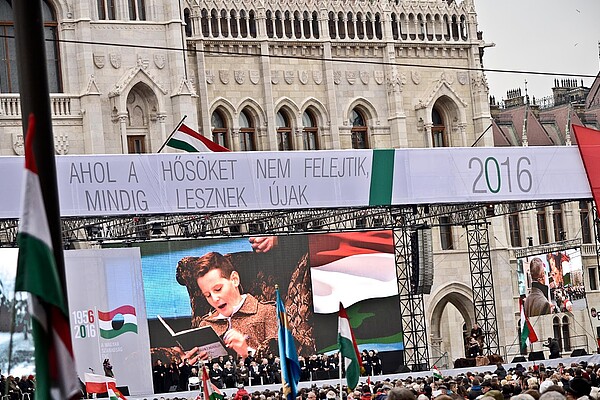
The Hungarian revolution of 1956 was one of the key events in recent Hungarian history. The celebrations surrounding its sixtieth anniversary took a new, yet expected turn when Viktor Orbán used it as an opportunity to criticise the European Union and further the Fidesz nationalist agenda. This article analyses the 2016 celebrations by tracing this commemorative event from 1989 onwards and by more closely analysing the speeches and festivities of 2016. It shows that this date has been frequently used by governing parties for partisan purposes (not just by the Right) and asks whether this has had consequences for the way in which the events of 1956 are being remembered, and what role they still play in the Hungarian collective memory.
The main festivities surrounding the sixtieth anniversary of the 1956 Hungarian uprising took place on the weekend of 22–23 October 2016. On Saturday, there were free tours of the parliament building, and on Sunday an official rally took place in front of the parliament building on Kossuth Square. Additionally, on that day the entrance to the National Museum and to the House of Terror was free. The celebrations included not only temporary exhibitions and lectures, but also countless billboards. Historical trams, turned into 'revolutionary' trams, glided through Budapest as a reminder of the revolution's heroes.
The scale of the 1956 anniversary celebrations stands in close correlation to the present political situation in Hungary. The memory of the events in 1956 was crucial to the new political identities emerging in the early 1990s, but afterwards its importance seemed to be waning until the 'revival' in 2006. Following this, it was kept small, with rallies gathering hundreds rather than thousands of people. Subsequently, the sixtieth anniversary saw a return to the form of a mass event. To understand the underlying causes of this fluctuation we need to take a look at the 1956 revolution itself as well as at the movements within the Hungarian political scene since 1989.
The uprising broke out on 23 October 1956 in Budapest and spread rapidly to the other parts of the country. It was a consequence of several events that had taken place both in Hungary and throughout the Soviet-controlled bloc since Stalin's death in 1953. Most immediately it was the resignation by the General Secretary of the Hungarian Communist Party, Mátyás Rákosi, in June 1956 that triggered the events. An uprising among Polish workers in Poznań that was subsequently put down by the government also had an impact as it had opened up a space for negotiation between the Polish government and the Soviet leadership. These events, together with the re-establishment of the Union of Hungarian University and Academy Students, that had been banned under Rákosi, created a climate of hope in society. On 22 October, students of the Technical University in Budapest formulated a list of 16 policy demands. On the next day, both 'The Hungarian Writers Union' and the students organised demonstrations sympathising with the pro-reform movements in Poland. Over the course of the day, around 200 000 people gathered under the statue of Józef Bem, a Polish general who played an important role in the Hungarian Revolution of 1848, and reformist demands were read. The notion of national sovereignty was central to the demonstrators, allowing them to draw a direct parallel between the events of 1848 and 1956. We shall return to this issue later.
The hopeful atmosphere quickly came to an end. That evening, the first shots were fired – supposedly by the Hungarian Secret Police (ÁVH) – and in response, the demonstrators resorted to violence as well. The fighting escalated over the next few days until Imre Nagy was appointed Prime Minister on 28 October; he was the last member of the communist government deemed credible both by the Soviets and by the demonstrators. He announced an immediate ceasefire and dissolution of the ÁVH, but he did not address the revolutionary demands until 1 November. It was only after receiving the news of the pending Soviet intervention that he declared Hungary's withdrawal from the Warsaw Pact. On the same day, the Soviet army crossed the Hungarian border and aimed for Budapest. Despite the unequal state of preparedness (civilians with makeshift weapons against an army with tanks), resistance in Budapest lasted until 3 November and in some parts of the country the strikes went on even longer.[1]
In the meantime, János Kádár, another prominent communist from the Stalinist era, proclaimed the Hungarian Revolutionary Worker-Peasant Government to be under Soviet protection, and declared the events a counter-revolution. After he became the Prime Minister on 8 November, he began to systematically extinguish the revolution, a process that carried on well into the 1960s. Twenty-two thousand people were incarcerated, 200 000 emigrated and around 450 were executed, including Imre Nagy himself. The victims were buried in unmarked graves in Parcel 301, a place at the back of the Új Köztemető cemetary on the outskirts Budapest. The memory of 1956 was heavily supressed during the 30 years of Kádár's regime and the events were not to be spoken of, even by the victims and their family members.[2] The fact that in 1988 the Hungarian General Secretary, Károly Grosz, gave permission to rebury Imre Nagy even though his rehabilitation was still declared impossible, was an important sign for Hungarians that a change was coming.[3]
Parcel 301 was exhumed in March 1989 and Imre Nagy was symbolically reburied on 16 June 1989. The event was spontaneously attended by some 300 000 people and various political factions including members of the Hungarian Socialist Workers' Party. Many speeches were given but the most famous one was delivered by Viktor Orbán, back then just a charismatic 26-year-old member of the opposition party called the Alliance of Young Democrats, better known as Fidesz (Fiatal Demokraták Szövetsége). It is worth mentioning that originally Fidesz was considered a liberal party; the last two decades saw them abandon liberalism for conservatism, finally settling down as a centre-right catch-all party.[4] In 1989, Orbán had already used the opportunity to attack the socialists, a strategy never abandoned by Fidesz:
We cannot understand that those who were eager to slander the revolution and its leader have suddenly changed into great supporters of Imre Nagy. Nor can we understand that the party leaders, who made us study from books that falsified the revolution, now rush to touch the coffins as if they were charms of good luck.[5]
According to the historian Gábor Gyáni, following the speech at Nagy's funeral, Fidesz further usurped the memory of 1956 for itself and, since the late 1990s, claimed the role of being the sole narrator of the events. Fidesz portrayed the revolution as an event for the 'everyman' and the transition as a delayed consequence thereof, thus turning "an image of the past into a mere reflection of the future".[6] What is more, the act of aligning 1989 with 1956 and, as previously mentioned with 1848, reinforced the notion of national sovereignty as central to the emerging political discourse.
The reformist wing of the Hungarian Socialist Workers' Party formed the Hungarian Socialist Party (MSZP) in 1989 and has formed three governments since: in 1994, 2002 and 2006. Today, the MSZP remains one of the strongest parties in the Hungarian parliament and it forms a coalition with four other left-wing parties – the small fish of the Hungarian political scene. Fidesz is two years into its second term of office in a right-wing coalition with the Christian Democratic People's Party (KDNP). Their strongest opponent is the far-right party Jobbik, who hold 12 per cent of the seats in parliament. All of these parties had their own take on the sixtieth anniversary of 1956, with the Fidesz narrative dominating the scene.
It is important to keep in mind that this was the first big celebration since the eventful fiftieth anniversary in 2006. At that time, the Hungarian Socialist Party (MSZP) was in power. Shortly before the anniversary, the notorious 'lies speech' was leaked to the media, in which then Prime Minister, Ferenc Gyurcsány, admitted to having lied about the financial situation of the country during the elections. As the anniversary was the first national holiday since the leak a lot of people used it to voice their protest and angry crowds took to the streets, ending up storming and vandalising the Television building. The MSZP did not budge despite the scandal, which ultimately allowed Fidesz to win subsequent elections with a supermajority for the following term in 2010.
The anniversary celebrations between 2006 and 2016 had been relatively small. However, the sixtieth anniversary seemed like a good chance for the Fidesz-led government to reaffirm its position on the domestic as well as on the international scene, especially in light of popular protests and unrests in the preceding two years. In addition to the previously mentioned lectures, trams and exhibitions, the memorial committee that had been established for the occasion launched a blog called Freedom First that was "dedicated to the heroism and sacrifice of the freedom fighters of the Hungarian Revolution of 1956 and all who supported them". They also had a theme song entitled, Egy szabad országért (translated as "Steps of Champions", literally "for the free country") written by the American songwriter of Hungarian origin, Desmond Child. Moreover, Freedom First also has its own YouTube channel featuring making-of videos, interviews, promotional materials and 'historical' materials. One thousand events in total – 300 in Budapest alone – took place in Hungary in 2016 and another 381 were organised abroad.
The main event on 23 October started at 3 p.m. in Kossuth square in front of the parliament building. At that time, the square was so packed that it was impossible to get close to the main stage, let alone to a place where one could see anything. A dramatized reading of excerpts from the Journal of the 1956 Revolution by Gyula Csics was shown, and afterwards both the Polish president Andrzej Duda and Viktor Orbán held speeches. In the evening, there was the Freedom Concert (Szabadságkoncert) organised at the Papp László Budapest Sportaréna.
The speech held by Viktor Orbán is a good illustration of the way that Fidesz continues to utilise the memory of 1956 for its political agenda.[7] As was already mentioned above, the revolution was presented as a national phenomenon thereby downplaying the significant role of workers in it. Interestingly enough, the paragraph where Orbán accounts for the different groups engaged in the revolution, is a mirror image of a paragraph from the speech he delivered on 15 March that same year during the anniversary of the Hungarian Uprising of 1848. This supports the view that the events of 1848, 1956 and 1989 are treated by Fidesz in a causal way, as if one event was the logical consequence of the other. To strengthen the 'national sovereignty' perspective, the degree of engagement by reform communists in the events of 1956 is played down. This includes as well – or especially – the figure of Imre Nagy. Orbán mentions him only once in the very beginning of the speech and never again. The same applies to the historical timeline. The thirty years of the Kádár regime are not spoken of again after the second paragraph of the speech. What is more, the collapse of communism is presented as if it happened just after 1956: "In Budapest in October 1956 the course of history was reversed. […] Communism, which until then was thought to be immovable, received a wound from which it was unable to recover." After praising the virtues of the Hungarian nation, Orbán moves into the offensive:
The reason we stuck in the throat of the Soviet empire and the reason it broke a tooth when it tried to bite on us was that we asserted our national ideals, that we stood together and did not surrender the love of our homeland. This is also why we shall not accept the EU's transformation into a modern-day empire. […] Today the task of Europe's freedom-loving peoples is to save Brussels from Sovietization […]. We Hungarians want to remain a European nation, not a minority in Europe.
After this, Orbán stresses once again the significance of the Christian roots shared by Hungary and Poland, which he depicts as the foundation of the free and strong Europe. Towards the end of the speech he inserts the refugee crisis of 2014–2016 into the 'revolutionary timeline' established before. To paraphrase: the enemy is coming from outside – this time in the form of refugees – and at the same time there is the enemy within, namely Brussels. Yet again, the Hungarians need to be courageous and fight for their freedom and their right to self-determination. Orbán attacks the "profit-seekers, […] the do-gooders and naive souls who have no idea of the extreme danger towards which they are pushing Europe". In his opinion, the European Union advocates a cheap, easy way out of the current crisis that will ultimately lead to its demise. He praises the Hungarians who have chosen the right solution: their own children instead of immigrants; improving the job market instead of living off welfare benefits; and "border protection instead of the white flag of surrender". Thus, in Orbán's words, Hungary becomes the protector of Europe.
The rhetoric of endangered national sovereignty resonates well with Fidesz voters. Just three weeks prior to the anniversary, the referendum on refugee quotas had taken place. Here, voters had been asked to answer the following question: "Do you want to allow the European Union to mandate the resettlement of non-Hungarian citizens into Hungary without the approval of the National Assembly?" The government's campaign for a 'no' vote relied largely on fearmongering; bombarding the inhabitants of Hungary with scary 'information' about all the presumed dangers linked to the refugees. However, despite the unprecedented size of the campaign (e.g. Fidesz bought approximately 6000 out of 20 000 billboards available in the country) the voter turnout had been too low for the referendum to be valid.
Orbán's interpretations of 1956 during the sixtieth anniversary celebrations did encounter some opposition, however. A diverse group of demonstrators gathered on the corner of Kossuth square by the statue of Imre Nagy. Whistles served as their main prop, a fact not omitted by Orbán in his speech when he said that communism "still comes back to jeer and whistle". Truth be told, the boos and whistles were impossible to hear from more than 50 metres away, so the goal of disrupting the ceremony was clearly not achieved. The crowd that gathered there represented different age groups and motivations. Some demonstrators brought along issues of the recently shut down opposition newspaper Népszabadság; others had signs with slogans like "Viktor take your comrades and piss off"; some had Hungarian flags with a Sauron-like ring in the middle (the Hungarian flag with a hole where the Soviet emblem used to be is the main symbol of 1956); and some simply held up red penalty cards.
The gathering of protestors was separated from the main crowd by a heavy police cordon and it was quite difficult to get from one place to the other. It was reported later that some 'whistle-blowers' who went into the main crowd, including a prominent Hungarian historian Krisztián Ungvary, were physically assaulted, as news agencies documented. The media reports about these incidents, however, remained vague. According to the Hungarian Free Press the counterdemonstrators succeeded in rendering Orbán's speech inaudible, which seems improbable considering the number of protesters. Moreover, their audio set up was simply not good enough to reach across such a huge area.
There were also other alternative voices to be heard against the government narrative of 1956. Jobbik, the extreme right-wing party, gathered their followers in Corvin köz square and the representatives of various leftist opposition groups (e.g. the Civil Opposition, the Democratic Resistance, the Movement for Modern Hungary) held meetings in different points around the city including the 1956 square and the Új Köztemető (the resting place of the victims of 1956). The biggest opposition rally attended by the Civil Forum (Civil Fórum) – the so called Szabadságszín – took place on Blaha Lujza square. It was attended by activists, artists and leaders of opposition parties, including the disgraced ex-Prime Minister, Ferenc Gyurcsány.
The group called Living Memorial – my history (Eleven Emlékmű – az én történelmem) who is known for its installation in front of the controversial monument dedicated to the victims of German invasion (see pictures) erected a series of four panels in front of the House of Terror titled, "Living ‘56: The Non-amended Memory of the Revolution". All of the panels included a small inset with the questions: "Did you know that this was also part of the 1956 revolution? Do you agree that no one should appropriate history? These are a couple of things that are being left out of the official narrative". The signs were then dedicated to the intellectuals and politicians, to the journalists and writers, to the Imre Nagy group, and to the students and workers detailing the role they played in the revolution. The Living Memorial group does not only create installations; it has also been organising biweekly discussions at the Szabadság square for over two years now. They strive to create community spaces where spontaneous, un-politicised – living – memory is possible. Due to the open character of their work, this might be the most inclusive form of remembrance currently accessible.
The large number of separate, seemingly competing events, organised by the opposition against the official celebrations is a good indicator – as are the narratives surrounding the events of 1956 – of how split the left side of the political spectrum is in Hungary today. Fidesz is establishing a particular narrative of the historical events that demonises communism and seeks to whitewash Hungary's participation in the Holocaust. In addition to the monument dedicated to the 'victims of German invasion', which was erected in Szabadság Square in 2014 through a government initiative, Fidesz also sponsored the establishment of the House of Terror, a rather controversial museum and memorial to the victims of communism. Moreover, in 2014, debates broke out again when the House of Fates project was announced – a Holocaust memorial that none of the Jewish communities in Budapest agreed to. It was a continuation of the Fidesz efforts to re-write twentieth century Hungarian history by placing an equal sign between the crimes of communism and the Holocaust, and ultimately denying Hungarian participation in either.
Judging by the disproportionate number of people that gathered on 23 October to listen to Orbán, and those who came to criticise him, the success of the Fidesz strategy seems quite apparent. The sixtieth anniversary was primarily an occasion for exhibiting one's political affiliation – to use Éva Kovács' words, "…the spontaneous collective[8] memory withdrew from political transition in 1993 and gave way to the politics of history".[9] Perhaps most noteworthy here is another aspect of this year's celebrations: other than the ceremonies held in the 1990s or in 2006, this event was not utilised in order to play out domestic issues, but rather to reinforce the Euro-sceptical direction that Hungarian foreign policy has taken.
It will be interesting to trace the form that the celebrations take on in the following years. Due to the parliamentary elections coming up in 2018, it seems unlikely that Fidesz will abandon its aggressive politics of history, especially since the support for Jobbik, their main opponent, has grown. Will the left side of the political spectrum consolidate? Can they regain control of the historical narrative?
Nora Borodziej: 1956 Reloaded: The Sixtieth Anniversary Celebrations of the Hungarian Revolution. In: Cultures of History Forum (16.02.2017), DOI: 10.25626/0059.
Copyright (c) 2017 by Imre Kertész Kolleg, all rights reserved. This work may be copied and redistributed for non-commercial, educational purposes, if permission is granted by the copyright holders. For permission please contact the editors.
See the Hungarian Spectrum's analysis of ongoing debates about the official 1956 commemorations last year: "The Dangers of being a Historian in Orban's Hungary"
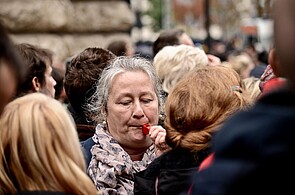
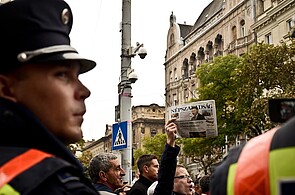
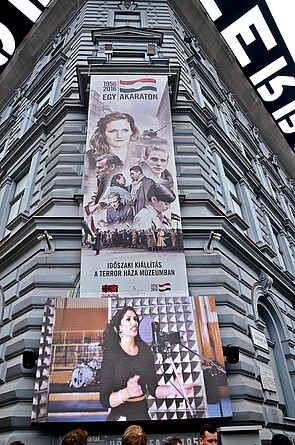
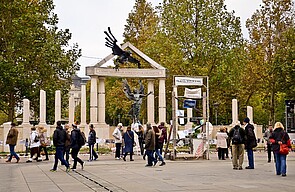
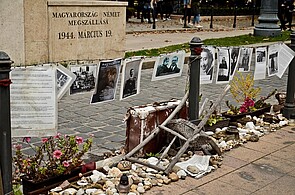
Ágoston Berecz · 18.01.2021
The Trianon Ramp and the Obstinate Memory of a Magyar Greater Hungary
Read more
Katalin Madácsi-Laube · 28.06.2020
A New Era of Greatness: Hungary‘s New Core Curriculum
Read more
Emily Gioielli · 07.02.2020
From Crumbling Walls to the Fortress of Europe: Changing Commemoration of the ‘Pan-European Picnic’
Read more
Kata Bohus · 31.10.2019
Éva on Insta: Holocaust Remembrance 2.0
Read more
János Gadó · 16.08.2019
The Splendour and the Misery of the House of Fates
Read more
Get this article as PDF download (including pictures).